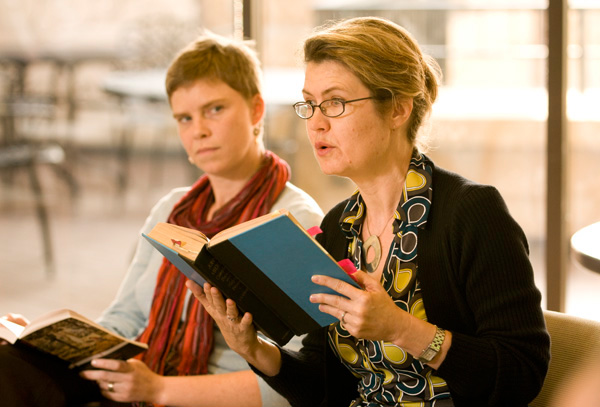New curriculum gives English majors the big picture
In a survey, students said they weren't getting the "big picture" of English literature. Faculty responded with a curriculum that bypasses a "March of the Masterpieces" approach and focuses instead on how literature develops and changes over time.
In a recent class at Pigott Hall, Roland Greene taught his students about the 17th century and the metaphysical poets John Donne, George Herbert and Richard Crashaw.
Just like the classes you took 10, 20 or 30 years ago, right? Not so.
According to Greene, a professor of English and of comparative literature, the change isn't so much in individual classes, but rather in the "arc of what we're trying to do over a period of time." This isn't the "March of the Masterpieces" approach of 30 years ago, nor is it the less structured format of five years ago.
During the academic year, Stanford's English Department has launched a new yearlong curriculum requirement for English majors, "Literary History," a core that embeds literature within the cultural, political, historical and religious context of England, America and the English-speaking nations. It also considers how texts, genres and literary movements develop as part of a very long, sometimes contentious conversation.
Nationwide, universities are beginning to sense that the English curriculum needs a 21st-century revamp. As the Chronicle of Higher Education reported in a recent study, "The English language is going through a time of huge growth. Humanity is forgetting its history more rapidly each year." Increasingly, for today's students, "the past is a foreign country," said Greene. The new core curriculum will give them more grounding.
In some ways, however, it's "forward into the past." Back in the 1960s and '70s, students protested for more freedom in deciding their own courses of study. The battle cry was for less structure, more choice. And they got it.

Professor of English Jennifer Summit reads from Paradise Lost at a daylong reading of the work to celebrate John Milton's 400th birthday in this 2008 photo. At left: Elizabeth Pentland of York University.
What followed in the subsequent decades was a system of "distribution requirements." For example, English majors might be required to take a course in medieval literature, or perhaps two courses in pre-1750 literature. Which electives they chose within that directive was entirely up to them.
The problem was that some of the courses students might choose considered only a single author (Thomas Hardy or Ezra Pound, for example). Or they might take a thematic approach, considering only one aspect of literature (women in Elizabethan literature), or represent only one genre (plays or gothic novels) or a particular intellectual problem.
According to Greene, it was often like "moving from a close-up to wide-angle shot, back and forth"– dizzying, without being enlightening.
It simply wasn't the case that "if students tick all the boxes, that will add up to a big view of literature," said Jennifer Summit, chair of the English Department. Unfortunately, she said, students might be left wondering, "What is the difference between the Reformation and the Restoration?"
In a routine department review and survey two years ago, the students maintained they weren't getting the big picture they needed. In short, they wanted more structure.
"This generation wants to have a firm sense of literary history, a common core of knowledge that they will share with other majors in the English Department and an intellectual framework that will enable them to devise a coherent course of study," according to the department.
According to Summit, "Literary History is basically the big-picture story of how literature develops and changes across a very long stretch of time. It asks what are the major texts, literary movements and generic shifts that occur over time" and also "how historical conditions – including the history of literacy and technologies of writing as well as the broader histories of political, social, intellectual and cultural movements – affect, and are reflected in, literary texts and their meanings and uses."
Let's go back to Greene's classroom. One change that may have gone unnoticed by the casual observer: Summit is sitting in the classroom along with the students.
Her presence isn't whim or happenstance; the two were team-teaching the fall class. All the courses in the Literary History series are team-taught, and by some of the department's most stellar faculty members. Together, they represent the spectrum of English literature from medieval to contemporary, British to American, and English speakers everywhere.
All eight of them – including Denise Gigante, Blair Hoxby and Judith Richardson for the winter quarter; Ursula Heise, Nicholas Jenkins and Franco Moretti for the spring – gathered on the opening day of class last fall to meet the students and map out the coming year.
The team-teaching is more than window dressing. In class, the faculty "teammates" question each other, present alternate points of view to the lecture and generally give the English majors a chance to see how faculty members think about an issue and how they question each other from the perspective of their different specialties.
"What you get out of a text depends on the questions you ask," said Summit, and watching faculty interactions teaches students how to think about literature.
Moreover, the class delivers a format that is familiar to students – the talk-back and discussion panels ubiquitous on television.
For the professors, the new core curriculum provides an opportunity to tailor their teaching approaches. Summit said she taught a bit differently this term, knowing that Ursula Heise, an English professor with interests in contemporary media, would be teaching in the spring.
It also gives faculty a chance to resist the Balkanization too prevalent in the field, where individuals might know very little about the periods before or after their areas of interest. Faculty and students need to understand what came before and what comes next.
All are strong selling points for the faculty, who approved the new curriculum –
with its strengthened emphasis on teaching – unanimously.
"It taps into an ethos that's already here and very longstanding," said Summit. "It wasn't hard to get us together."
Stanford is not alone in recognizing the need to refocus the English curriculum, but it has been early in finding and implementing a remedy. Some aspects of its academic remodeling are unique, such as the three-quarter scope of Literary History.
"It's a work in progress," said Greene. "It's been pretty successful this year."
The national buzz already has started, and Summit is fielding questions, speaking engagements and writing invitations.
Structure or freedom? "More structure and more freedom," she tells them.
Media Contact
Cynthia Haven, Stanford News Service: (650) 724-6184, cynthia.haven@stanford.edu


Share This Story